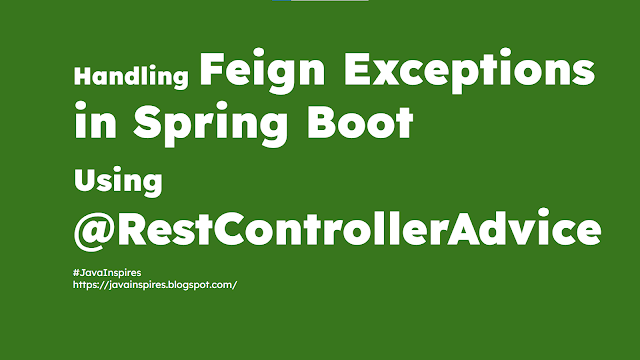Handling Feign Exceptions in Spring Boot Using @RestControllerAdvice
Handling exceptions is a crucial aspect of developing robust microservices, especially when dealing with communication between services. In Spring Boot applications, Feign clients are commonly used for making HTTP requests to other microservices. However, it's essential to handle exceptions gracefully when errors occur during these communication attempts.
In this guide, we'll explore how to handle Feign exceptions in Spring Boot using @RestControllerAdvice.
Introduction
Feign is a declarative web service client library that simplifies making HTTP requests in Java applications. Spring Boot seamlessly integrates Feign clients, enabling developers to communicate with other services in a straightforward manner. However, errors can occur during these interactions, such as network issues, server errors, or invalid responses. Handling these exceptions appropriately is essential for maintaining application reliability and providing a good user experience.
@RestControllerAdvice is a powerful feature in Spring Boot that allows you to define global exception handling for Spring MVC controllers. By leveraging @RestControllerAdvice, you can centralize exception handling logic and ensure consistent error responses across your application.
1. Creating a Custom Exception Class
We'll start by creating a custom exception class to represent exceptions specific to Feign clients. This class will extend RuntimeException or any other appropriate superclass.
public class FeignClientException extends RuntimeException {public FeignClientException(String message) {super(message);}}
2. Writing a @RestControllerAdvice Class
Next, we'll create a class annotated with @RestControllerAdvice to handle exceptions globally. This class will contain methods annotated with @ExceptionHandler to handle specific types of exceptions, including FeignException.
import org.springframework.http.HttpStatus;import org.springframework.http.ResponseEntity;import org.springframework.web.bind.annotation.ExceptionHandler;import org.springframework.web.bind.annotation.RestControllerAdvice;import org.springframework.cloud.openfeign.FeignException;@RestControllerAdvicepublic class GlobalExceptionHandler {@ExceptionHandler(FeignException.class)public ResponseEntity<String> handleFeignException(FeignException e) {// Extract useful information from the FeignExceptionHttpStatus status = HttpStatus.resolve(e.status());String errorBody = e.getMessage(); // You may want to parse the response body for specific error details// Log the exception or perform any other necessary actions// Return a ResponseEntity with appropriate status code and error messagereturn ResponseEntity.status(status != null ? status : HttpStatus.INTERNAL_SERVER_ERROR).body(errorBody != null ? errorBody : "Feign Client Error");}// Add more exception handlers as needed}
In this example, the handleFeignException method is annotated with @ExceptionHandler and specifically handles FeignException. Inside this method, we extract relevant information from the exception, such as the HTTP status code and response body, and return an appropriate ResponseEntity with the error details.
3. Using Feign Client
Ensure that you're using Feign clients in your Spring Boot application to communicate with other microservices. Feign clients are interfaces annotated with @FeignClient that allow you to make HTTP requests to other services.
@FeignClient(name = "example-service", url = "http://example.com")public interface ExampleFeignClient {// Define your Feign client methods here}
Conclusion
By implementing global exception handling with @RestControllerAdvice, you can effectively manage Feign client exceptions in your Spring Boot applications. This approach centralizes exception handling logic, promotes code reuse, and ensures consistent error responses across your microservices architecture. Remember to customize the exception handling logic according to your application's specific requirements and error scenarios.
Handling exceptions gracefully is crucial for building resilient microservices that can withstand failures and provide a seamless user experience. With the techniques outlined in this guide, you'll be well-equipped to handle Feign exceptions effectively in your Spring Boot applications.
